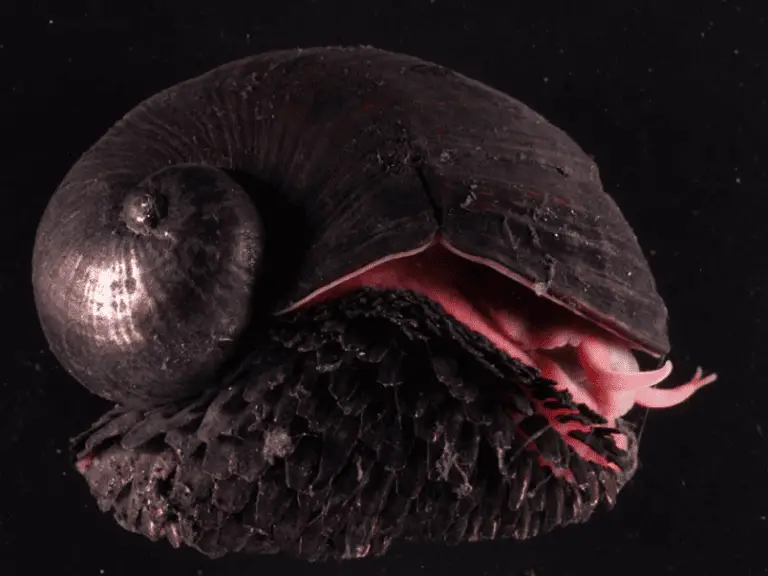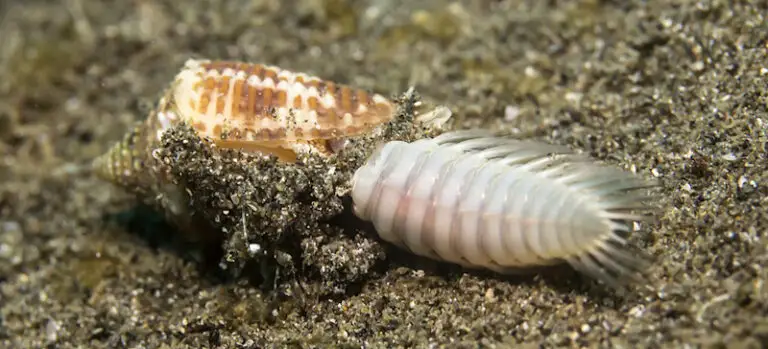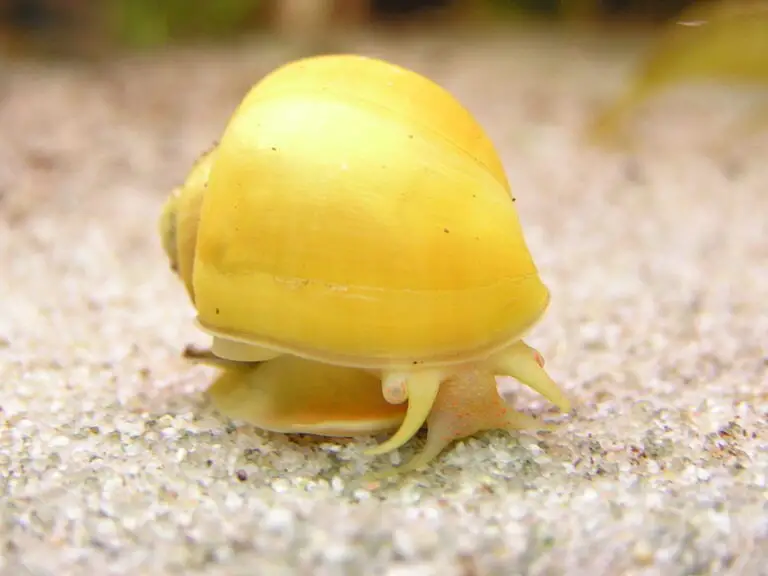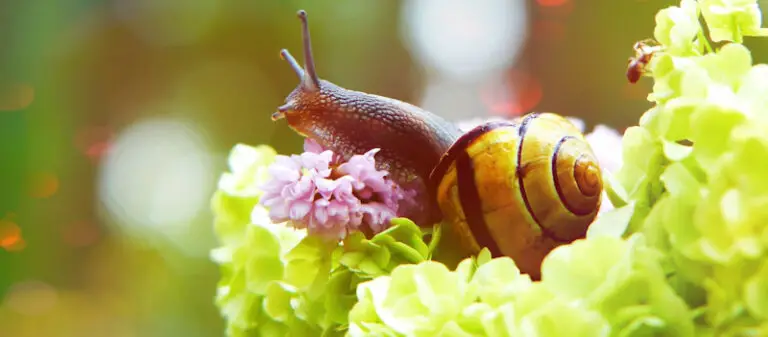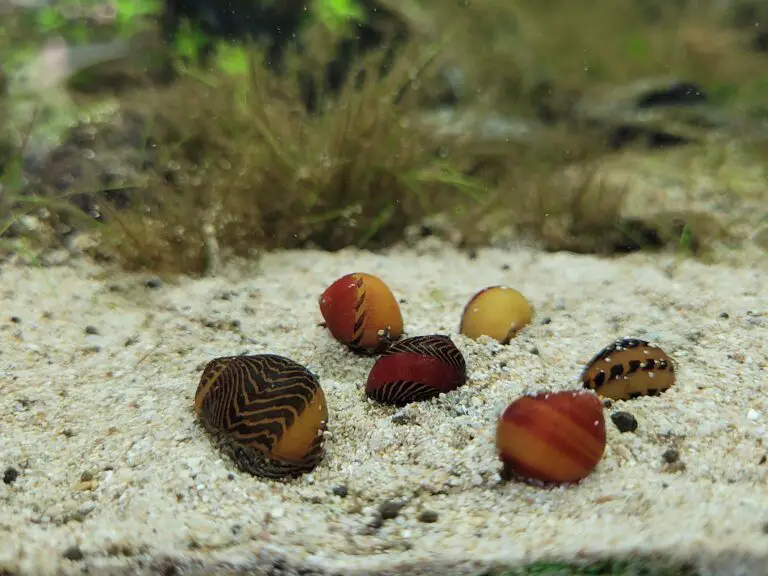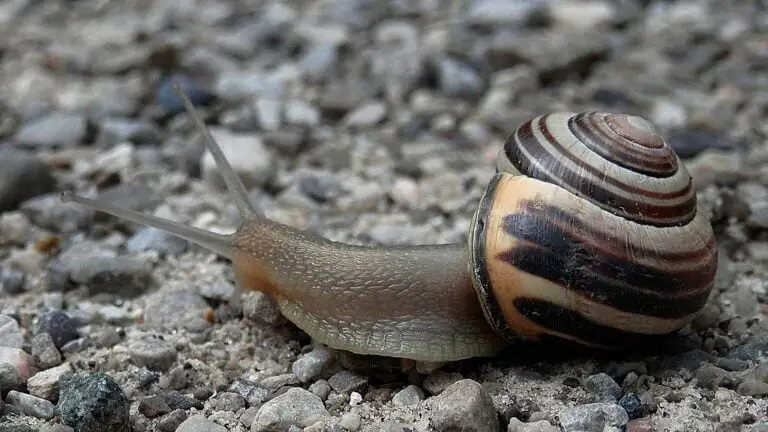Garden Snails: From Their Habits to Their Habitat
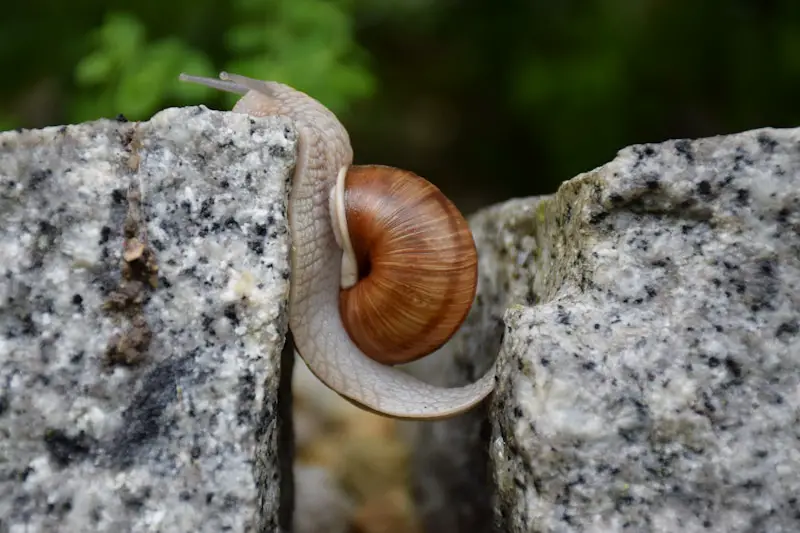
The Importance of Garden Snails in the Ecosystem
Garden snails, also known as Helix aspersa or Cornu aspersum, are small mollusks that can be found in many parts of the world. They are often considered pests by gardeners due to their tendency to munch on plants and leave slimy trails behind them.
However, these tiny creatures play an important role in the ecosystem and they have much more to offer than meets the eye. Garden snails are members of the gastropod family, which is one of the largest groups of mollusks.
They are hermaphrodites, which means that they have both male and female reproductive organs. This allows them to mate with any other garden snail they come across, making it easier for them to reproduce and increase their population.
The Ecosystem Services of Garden Snails
Despite their small size, garden snails play a crucial role in maintaining balance within the ecosystem. They help break down decaying plant matter into nutrients that can be absorbed by other plants, which benefits everything from flowers to trees.
Many birds and mammals also feed on garden snails, making them an important link in many food chains. Additionally, garden snails can act as indicators of environmental health.
Because they are sensitive to changes in temperature and moisture levels, their presence (or absence) can indicate whether or not an environment is healthy for other species as well. It’s also worth noting that garden snails have been used for centuries as a source of food for humans.
In some countries like France and Spain, escargot (cooked or baked land snail) is considered a delicacy! However, it’s important to note that harvesting wild garden snails should be done responsibly so as not to deplete populations.
Many people may view garden snails simply as pests or annoyances in their gardens or yards. But these small creatures actually play an important role in the ecosystem.
Yet, these small creatures fulfill vital roles in our ecosystem. They aid in decomposing plant matter and serve as food for other species. In doing so, garden snails help maintain the balance within the natural world.
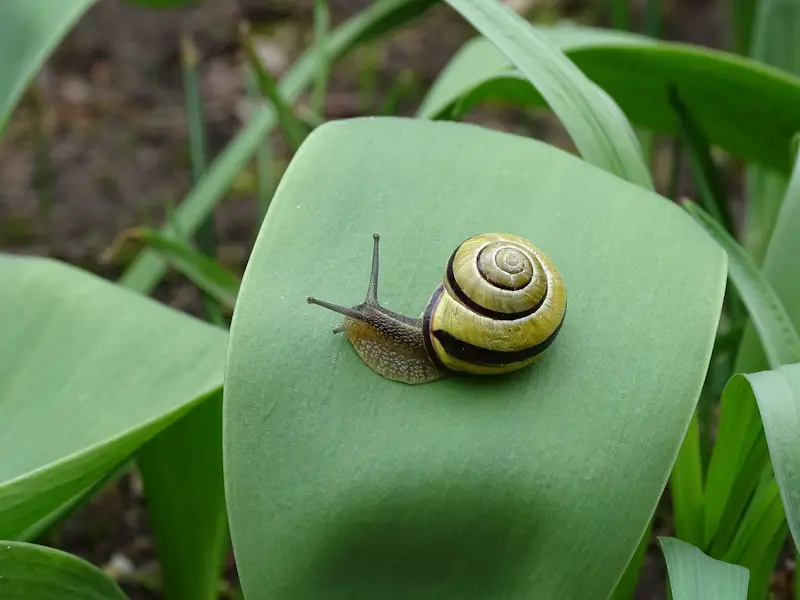
Physical Characteristics
Size and Shape of Garden Snails
Garden snails are fascinating creatures, and their physical characteristics are no exception. These slow-moving mollusks can range in size from about an inch to almost four inches in length, depending on the species.
The shell of a garden snail is coiled and spiraled, with a distinct opening called the aperture on one end. As they grow, these shells also become thicker and stronger to protect the snail from predators.
Despite its soft body, garden snails are not shapeless blobs – they have a distinct shape that makes them recognizable at first glance. They have a long head that extends out from under their shell, with two pairs of tentacles on top.
The longer pair has eyes at the end that can detect changes in light and motion. The shorter pair is used for smelling and sensing chemicals in their environment.
Color Variations and Patterns on Their Shells
One of the most striking features of garden snails is the variety of colors and patterns on their shells. Some species have plain shells that range from shades of brown to gray or cream, while others have colorful patterns or distinctive stripes. The Burgundy snail (Helix pomatia) has a creamy yellowish-brown shell with dark brown stripes around its rounded whorls.
Conversely, The Roman snail (Helix pomatia) has a yellow or honey-colored shell with vaguely darker bands giving it an attractive appearance. Interestingly enough, some garden snails even display bright colors like reds or purples!
These hues serve as warnings to potential predators since these particular colors signal danger across many animal species. Overall, garden snails are unique creatures with varied physical characteristics that make them interesting subjects for study by biologists, scientists as well as amateur observers alike.
Habitat and Behavior
Preferred Environments for Garden Snails
Garden snails, also known as Helix aspersa, are typically found in areas with moist soil and moderate temperatures. They tend to thrive in gardens with lots of vegetation, as they can easily find food and shelter among the plants. They are more commonly found in areas with moderate humidity levels, but they can also survive in dryer conditions if there is enough moisture to keep their skin from drying out.
Garden snails are considered pests by many gardeners due to their tendency to eat away at plant foliage and flowers. However, they do play a vital role in the ecosystem by breaking down organic matter and contributing nutrients back into the soil.
Daily Routines and Behaviors
Garden snails are most active during the night time hours when there is less risk of being eaten by predators or exposed to heat. During the day, they will typically hide under rocks or other objects to avoid being seen.
They move slowly along a trail of slime that they secrete from their foot, which helps them navigate through difficult terrain without getting stuck or caught. They have a keen sense of smell that allows them to detect food sources from several feet away.
When threatened, garden snails will retract into their shells for protection. If necessary, they can also release a foul-smelling liquid that deters predators from eating them.
Hibernation Habits during Winter Months
During colder months when temperatures drop below freezing, garden snails will enter into a state of hibernation known as estivation. They will seal themselves inside their shells with a layer of slime that acts as insulation against the cold weather.
During this time, their body temperature drops significantly and their metabolism slows down dramatically in order to conserve energy until warmer temperatures return. This can last for several months, depending on the climate and location.
In warmer climates, garden snails may not hibernate at all and instead remain active throughout the entire year. However, during particularly hot and dry periods, they will seek out cooler and moister areas to avoid dehydration.
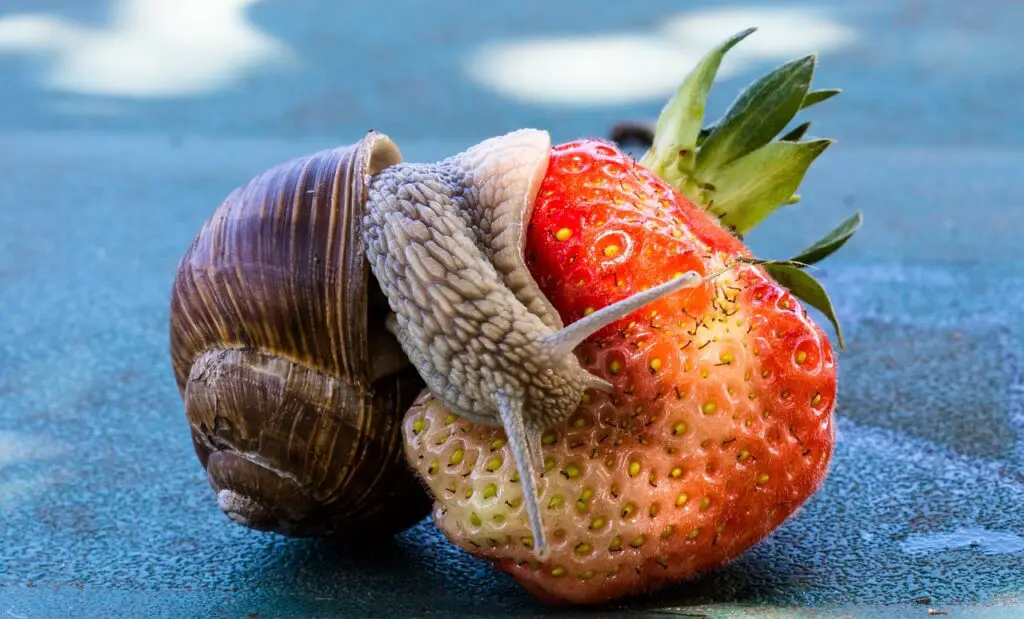
Diet and Nutrition
Types of Food that Garden Snails Eat
Garden snails are known for their ability to consume a wide range of food items. These little creatures are not picky eaters, and will feed on different types of plants, leaves, flowers and fruits.
They particularly like to eat soft root vegetables such as carrots, sweet potatoes, lettuce, and beans. They enjoy eating fruits such as apples, strawberries and melons.
Additionally, garden snails also feed on organic material found in soils like decomposing plant matter or other dead snails. They even eat the excrement of other animals as a source of protein!
Insects and eggs are also on the menu when available. While these creatures might seem destructive when they devour your beautiful plants in your garden or greenhouse, they can actually be beneficial for breaking down compost material and adding nutrients back into the soil.
Nutritional Value of Their Diet
One could argue that snail’s diet is better than some humans! Garden snails have a healthy diet filled with fiber-rich vegetables which help keep them regular (their digestive system tends to work more efficiently than ours).
The consumption of calcium-rich foods means their shells grow stronger so they’re better protected from predators. The nutritional value in garden snail’s diet is high compared to other animals their size.
A recent study found that garden snail’s shells were comprised of 99% calcium carbonate indicating the importance this mineral has in their diet for growth. Interestingly enough consuming different types of plants can affect the taste profile of cooked escargot (a traditional French dish made from land-based edible snails) which can be enjoyed by humans too!
It’s important not to overfeed domesticated pet-snails because unlike wild ones they do not have access to hibernation which allows them to digest larger meals more gradually. Owners of snails need to ensure they’re providing a diverse range of foods and not overfeeding their pet as this can lead to lethargy.
The diet of garden snails consists mostly of fresh fruits and vegetables which are high in important nutrients like fiber, vitamins, and minerals such as calcium. It’s fascinating how such little creatures can maintain a balanced diet from the wide variety of plants they consume!
Reproduction and Life Cycle
Mating habits of garden snails
Believe it or not, garden snails have a lot going on when it comes to their mating habits. They are hermaphrodites, meaning they have both male and female reproductive organs. When two garden snails mate, they each fertilize the other with their sperm.
It’s important for them to mate with other individuals to ensure genetic diversity in their offspring. Mating usually takes place during the evening or early morning hours and can last for several hours.
Egg-laying process and incubation period
After mating, garden snails lay their eggs in a shallow hole in moist soil. The hole is then covered up by the snail using its foot.
Garden snails can lay anywhere from 30-100 eggs at once, depending on the species. The incubation period for garden snail eggs is typically around two to four weeks.
Once the baby snails hatch from their eggs, they are very small–only about 1-2 millimeters long! They are also very vulnerable at this stage since they don’t yet have shells to protect them from predators or harsh environmental conditions.
Development stages from hatchling to adult
As the baby snails grow, they begin developing their shells which will eventually harden and protect them from predators and other dangers in the environment. Garden snail shells grow larger as they age–it’s possible to tell how old a garden snail is just by measuring its shell! It takes about two years for a garden snail to reach sexual maturity–at this point it will be fully grown and able to reproduce.
Garden snails can live for up to five or six years if conditions are favorable. Overall, the life cycle of a garden snail is fascinating!
From mating habits to incubation periods and development stages, there is a lot to learn about these little creatures. It’s important to remember that even though they may seem small and insignificant, garden snails play an important role in the ecosystem as decomposers and prey for other animals.
Predators and Threats
Natural Predators of Garden Snails
Garden snails may seem small and harmless, but they are actually preyed upon by a variety of animals. Some common predators include birds, rodents, hedgehogs, and even other snails!
In addition to these animals, some parasitic flies lay their eggs on garden snails, which eventually hatch into larvae that feed on the snail’s body. One of the most interesting natural predators of garden snails is the decollate snail.
This species is often introduced to gardens as a means of controlling the population of garden snails. Decollate snails have a cone-shaped shell and feed exclusively on other snails.
Human Threats such as Pesticides, Habitat Destruction, etc.
While natural predators play an important role in controlling garden snail populations, humans pose a significant threat to these creatures as well. One major threat comes from pesticides that are used in gardens and farms to kill pests such as aphids or caterpillars.
Most pesticides are harmful not only to the targeted pest but also to other organisms in the area, including garden snails. Another threat to garden snails comes from habitat destruction.
As more land is developed for human use or cleared for farming purposes, natural habitats for garden snails become increasingly scarce. Additionally, pollution can make it difficult for these creatures to survive in their remaining habitats.
Overcollection is yet another human-caused threat faced by some species of garden snails. In some areas where certain species are considered delicacies or pests (such as escargot), people may collect large numbers of these animals without regard for population sustainability.
It’s important for us to understand and appreciate the role that garden snails play in our ecosystem. By taking steps to reduce our impact on their habitats and using alternative methods of pest control, we can help to ensure the survival of these small but important creatures.
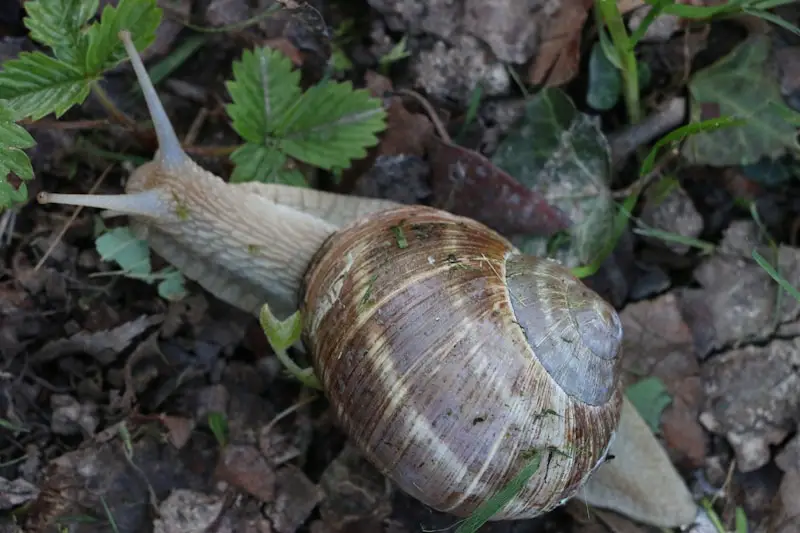
Fun Facts about Garden Snails
Unique Regenerative Abilities
Garden snails are unique creatures with some fascinating abilities. One of their most impressive traits is their ability to regenerate lost body parts.
If a snail loses its eye stalks or tentacles in a predator attack or accident, it can regrow them within a few weeks. This incredible regenerative ability not only helps garden snails survive in the wild but also serves as an exciting research topic for scientists studying tissue regeneration.
The World’s Largest Garden Snail
Did you know that garden snails can reach huge sizes? The largest recorded garden snail was almost 16 inches long and weighed around 2 pounds!
It belonged to a species called Achatina achatina, commonly known as the Giant African Land Snail. These massive gastropods are native to West Africa but have been introduced to other parts of the world, where they have become invasive species due to their voracious appetite and rapid reproductive rates.
Different Types of Garden Snails
There are over 200 different species of garden snails worldwide, each with its unique characteristics and habits. Some species have larger shells than others, while others have more colorful patterns on their shells. Some are more active during the day, while others prefer the cover of darkness to move around.
A Slow But Steady Pace
Garden snails may not be the fastest animals out there, but they sure are persistent. They can travel up to 50 yards per hour, covering distances that seem unimaginable given their size and pace. Moreover, they leave behind a slimy trail wherever they go – this mucus secretion acts as a lubricant and allows them to glide smoothly over rough surfaces.
Sleeping Habits of Garden Snails
Garden snails are nocturnal creatures and prefer to sleep during the day when it’s hot outside. They usually find a quiet, shady spot to rest and retract themselves into their shell to conserve moisture. However, when the weather is favorable, they may come out to bask in the sun or look for food.
Conclusion
Garden snails may seem like insignificant creatures, but they play a vital role in our ecosystem. They provide a source of food for many animals, and also help to break down decaying plant matter. Without garden snails, we could see a negative impact on the environment.
By understanding the behavior and habits of garden snails, we can better protect them from harm caused by humans and other predators. For example, using natural pest control methods instead of pesticides can prevent harm to not only garden snails but other beneficial insects as well.
It’s also important to remember that garden snails are living beings with their own unique personality traits and behaviors. Just because they are small and often overlooked doesn’t mean they don’t matter.
Next time you see a garden snail in your backyard or on a nature walk, take a moment to observe it and appreciate its beauty. You may be surprised at what you can learn about these fascinating creatures.

